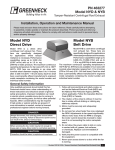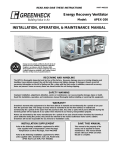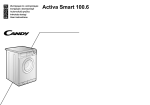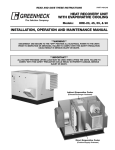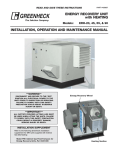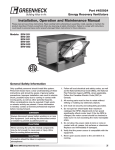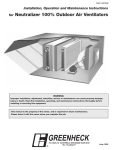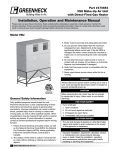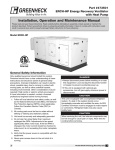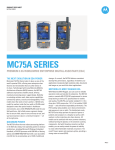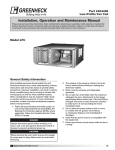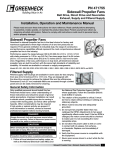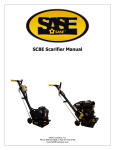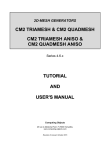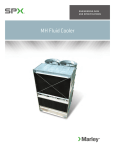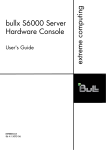Download Greenheck Fan PVE-35 User's Manual
Transcript
Part #472846 Heat Recovery Ventilators ® Installation, Operation and Maintenance Manual Please read and save these instructions. Read carefully before attempting to assemble, install, operate or maintain the product described. Protect yourself and others by observing all safety information. Failure to comply with instructions could result in personal injury and/or property damage! Retain instructions for future reference. Models: PVe-20 PVe-35 PVe-45 PVe-55 General Safety Information Only qualified personnel should install this system. Personnel should have a clear understanding of these instructions and should be aware of general safety precautions. Improper installation can result in electric shock, possible injury due to coming in contact with moving parts, as well as other potential hazards. Other considerations may be required if high winds or seismic activity are present. If more information is needed, contact a licensed professional engineer before moving forward. DANGER Always disconnect power before working on or near this equipment. Lock and tag the disconnect switch or breaker to prevent accidental power up. CAUTION When servicing the unit, the internal components may be hot enough to cause pain or injury. Allow time for cooling before servicing. CAUTION Precaution should be taken in explosive atmospheres. 1 Model PVe Heat Recovery Unit 1. Follow all local electrical and safety codes, as well as the National Electrical Code (NEC), the National Fire Protection Agency (NFPA), where applicable. Follow the Canadian Electric Code (CEC) in Canada. 2. All moving parts must be free to rotate without striking or rubbing any stationary objects. 3. Unit must be securely and adequately grounded. 4. Do not spin fan wheel faster than maximum cataloged fan RPM. Adjustments to fan speed significantly affects motor load. If the fan RPM is changed, the motor current should be checked to make sure it is not exceeding the motor nameplate amps. 5. Do not allow the power cable to kink or come in contact with oil, grease, hot surfaces or chemicals. Replace cord immediately if damaged. 6. Verify that the power source is compatible with the equipment. 7. Never open access doors to the unit while it is running. Receiving Upon receiving the product, check to make sure all items are accounted for by referencing the bill of lading to ensure all items were received. Inspect each crate for shipping damage before accepting delivery. Notify the carrier if any damage is noticed. The carrier will make notification on the delivery receipt acknowledging any damage to the product. All damage should be noted on all the copies of the bill of lading which is countersigned by the delivering carrier. A Carrier Inspection Report should be filled out by the carrier upon arrival and the Traffic Department. If damaged upon arrival, file claim with carrier. Any physical damage to the unit after acceptance is not the responsibility of Greenheck Fan Corporation. Unpacking Verify that all required parts and the correct quantity of each item have been received. If any items are missing, report shortages to your local representative to arrange for obtaining missing parts. Sometimes it is not possible that all items for the unit be shipped together due to availability of transportation and truck space. Confirmation of shipment(s) must be limited to only items on the bill of lading. Handling Units are to be rigged and moved by the provided lifting points or fork lifting points (see page 4). Handle each piece in such a way as to keep from scratching or chipping the coating. Damaged finish may reduce ability of the unit to resist corrosion. Storage Units are protected against damage during shipment. If the unit cannot be installed and operated immediately, precautions need to be taken to prevent deterioration of the unit during storage. The user assumes responsibility of the unit and accessories while in storage. The manufacturer will not be responsible for damage during storage. These suggestions are provided solely as a convenience to the user. Inspection and Maintenance during Storage While in storage, inspect units once per month. Keep a record of inspection and maintenance performed If moisture or dirt accumulations are found on parts, the source should be located and eliminated. At each inspection, rotate all moving components by hand ten to fifteen revolutions to distribute lubricant on motor and bearings. If paint deterioration begins, consideration should be given to touch-up or repainting. Units with special coatings may require special techniques for touch-up or repair. 2 Model PVe Heat Recovery Unit Machined parts coated with rust preventive should be restored to good condition promptly if signs of rust occur. Immediately remove the original rust preventive coating with petroleum solvent and clean with lint-free cloths. Polish any remaining rust from surface with crocus cloth or fine emery paper and oil. Do not destroy the continuity of the surfaces. Wipe clean thoroughly with Tectyl® 506 (Ashland Inc.) or the equivalent. For hard to reach internal surfaces or for occasional use, consider using Tectyl® 511M Rust Preventive or WD-40® or the equivalent. SUPPLY AIR AHU TableHeating of Contents OUTDOOR AIR UNIT (OA unit) EXHAUST AIR WITH HEAT RECOVERY Coil Basic Operation . . . . . . . . . . . .OUTDOOR . . 3 Cooling AIR Installation Coil Supplemental Installation, Operation and Maintenance Manuals . . . . . . . . . . . 3 Installation . . . . . . . . . . . . . . . . 3 Installation Stages . . . . . . . . . . . . . 4 72°F 50% Lifting with a Crane or Forklift . . . . . . . . 4 Roof Curb and Rail Mounting ZONE 2 Opening . . . . . . . . 4 Recommended Roof Service Clearances . . . . . . . . . . . . . 5 Roof Curb Mounting . . . . . . . . . . . . 6 RESTROOM Curb Dimensions and Weights . . . . . . . . 6 Ductwork Connections . . . . . . . . . . . 6 Rail Mounting / Layout . . . . . . . . . . . 7 Access Panel Description and Location . . . . 7 RELIEF . AIR Dimensional Data . . . . . . . . . . . . 8 Drain Trap . . . . . . . . . . . . . . 8 Electrical Information General Electrical Information . . . . . . . . 9 Control Center Components . . . . . . . . 10 Electric Heater Application/Operation . . . . 10 Optional Accessories Frost Control Application/Operation . . . . . 11 Economizer Application/Operation . . . . . 11 Variable Frequency Drives and Wiring . . . 12-13 Typical Wiring Diagram . . . . . . . . . . 14 Sensors and Lights . . . . . . . . . . . . 15 Remote Control Panel and Wiring . . . . . . 16 Sensors Mounted by Factory . . . . . . . . 17 Sequence of Operation Start-Up General Start-Up Information . . . . . . . . 18 Optional Accessories . . . . . . . . . . . 19 Unit Start-Up, Fans . . . . . . . . . . . 20-21 Routine Maintenance Checklist Overview . . . . . . . . . . . . . . . . 22 General . . . . . . . . . . . . . . . . . 23 Fan Belts . . . . . . . . . . . . . . . . 23 Fan Motors . . . . . . . . . . . . . . . 23 Fan Wheel and Fasteners . . . . . . . . . 24 Fan Bearings . . . . . . . . . . . . . . 24 Filters . . . . . . . . . . . . . . . . . 24 Door Seal Maintenance . . . . . . . . . . 24 Parts List . . . . . . . . . . . . . . . . 25 Sequence of Operation . . . . . . . . . . 25 Troubleshooting – Airflow . . . . . . . . . 26 Troubleshooting – Unit . . . . . . . . . 27-28 Maintenance Log . . . . . . . . . . . . 29-31 Warranty . . . . . . . . . . . . . Backcover Basic Operation Exhaust The PVeFan brings in fresh outdoor air and removes stale exhaust air from the building. Prior to discharging the exhaust air, the plate heat exchanger transfers energy from the exhaust air to the incoming outdoor air. When used in the cooling mode, heat energy is transferred from incoming outdoor air to the exhaust Plate air.Heat Simply put, this unit preconditions the outdoor air to save money on heating and cooling costs. Exchanger OUTDOOR AIR SIDE VIEW RETURN DUCT SUPPLY DUCT Supplemental Installation, Operation and Maintenance Manuals Refer to the following Installation, Operation and Maintenance Manuals for additional details: Part #462844 — Exhaust Weatherhood Additional manuals are available for each accessory used in the PVe. These additional manuals are provided by the respective manufacturers and are included with unit shipment. Installation The system design and installation should follow accepted industry practice, such as described in the ASHRAE Handbook. Adequate space should be left around the unit for filter replacement and maintenance. Sufficient space should be provided on the side of the unit for routine service and component removal should that become necessary. See Service Clearances and Access Panel Description sections for more details. Warning All factory provided hoisting and fork lifting points must be used when lifting the unit. When rigging for hoisting with a crane, spreader bars must be used. Failure to comply with this safety precaution could result in property damage, serious injury or death. See Installation Stages for additional details. Model PVe Heat Recovery Unit 3 Installation Stages Once the PVe Heat Recovery Ventilator is delivered to the jobsite, the actual installation occurs in several distinct stages. 1. Installation location must be carefully considered. Service clearances needed for later maintenance of the unit must be taken into consideration, access to Return Air and Discharge Air ducting must be anticipated. And structural support of the unit must be taken into consideration. See appropriate sections of this manual for further information. If electric wiring is going to be brought into the cabinet from beneath (recommended), preparations for that step must be taken during the planning stage. If possible, a GKD curb should be installed prior to installation of roofing materials so that flashing can be run up the sides of the curb. 2. Hoisting the cabinet can be accomplished with either a crane or a fork lift. If a forklift is used, the forks must extend all the way through the cabinet and project from the far side. The forks should be padded with a layer of ¼-inch thick plywood or other suitable material. If a forklift is used, the cabinet cannot be lowered directly onto the GKD curb unit because the forks will be in the way. It will be necessary to set the unit onto appropriate dunnage for final lowering after the forks are removed. If a crane is used, hoisting points are provided at each corner of the cabinet. Small, padded hooks must be inserted into the hoisting points. There is very little internal clearance inside the cabinet base and the use of large lifting hooks will either dig into the cabinet structure or else interfere with the seating of the cabinet on the GKD curb. 2. Physical installation of the unit should be completed prior to installation of electrical wiring. Condensate drains should be connected and if necessary, heat strips installed on the drains to prevent freezing of the traps. A final check should be made to ensure that the unit has been installed level by using the bottom of the cabinet as a reference, not the top (the cabinet roof is sloped to the rear). Ensure that all ductwork has been properly and permanently assembled. 3. Prior to wiring the unit, installer should verify that all optional accessories are accounted for. Verify that electric components such as motors are rated properly for the voltage actually being used. Note that some of the illustrations and pictures used in this manual show the use of three phase power and if the user actually has single phase power, there will be minor variations present. The unit should be wired according to the supplied wiring diagrams and Best Practices. Careful testing and balancing of the power source should be accomplished at this time. 4 Model PVe Heat Recovery Unit Lifting Forklift lifting points Crane hoisting points (typical) Lifting with a Crane 1. Before lifting, be sure that all shipping material has been removed from unit. 2. To assist in determining rigging requirements, weights are shown below. 3. Unit must be lifted by simultaneously hoisting at all four corner lifting points provided on base structure, ensuring proper load distribution and support at each corner. 4. Rigger to use suitable mating hardware to attach to unit corner lifting points. 5. Spreader bar(s) must span the unit to prevent damage to the cabinet by the lift cables. 6. Always test-lift the unit to check for proper balance and rigging before hoisting to desired location. 7. Never lift units by weatherhoods. 8. Never lift units in windy conditions. 9. Preparation of curb and roof openings should be completed prior to lifting the unit and setting on the curb. The weights shown are a Unit Weights (lbs.) worst case scenario based Approx. on the sheet metal and Model Weight component weights for PVe-20 1300 the unit. These weights include sheet metal weights PVe-35 1600 added together with the PVe-45 2100 largest motors, blowers and PVe-55 2700 accessories for the units. Lifting with a Forklift Unit base rail includes forklift lifting locations. Use weights shown to determine forklift size requirements. Roof Curb and Rail Mounting Service Clearances When installed on a roof, a typical installation will include at least one roof penetration in order to deliver return air to the unit from the space. Additionally, a second roof penetration may be used for supply air discharge to the space. Option Bottom Top Side X D EA RA NC E CE AN A D End X D X A X D X By pa ss Filters Outdoor Air Hood Fa ce / EA Discharge am pe r RA Intake CL C AR OA Intake SA Discharge B E CL Intake and Discharge Options Plate Heat Exchanger B Filters OA - Outdoor Air SA - Supply Air (to the space) RA - Return Air (from the space) EA - Exhaust Air Exhaust Air Hood Filters Face Damper B SA Discharge D C C D PVe-20 36 (920) 36 (920) 36 (920) 60 (1530) PVe-35 48 (1220) 36 (920) 36 (920) 60 (1530) PVe-45 60 (1530) 36 (920) 36 (920) 60 (1530) PVe-55 72 (1830) 36 (920) 36 (920) 60 (1530) All dimensions are shown in inches (millimeters). The weatherhoods include 2-inch aluminum mesh filters that are removed out of the end of the hood as shown in this drawing and require extra clearance for removal. Do not face the Outdoor Air Intake of the unit into prevailing wind and also keep the air intake away from any other exhaust fans. Likewise, position the Exhaust Air Discharge opening away from any other outdoor air intakes of other equipment. E F RA Intake B Control Center A OA Intake A C EA Discharge Plate Heat Exchanger SA Discharge Model E Bypass Damper Outdoor Air Hood D D Duct Dimensions Model A B C D E F PVe-20 10.7 (280) 12.2 (310) 10.3 (270) 11.8 (300) 22.0 (570) 14.0 (360) PVe-35 11.9 (310) 13.7 (350) 11.4 (290) 13.1 (340) (870) 34.0 14.0 (360) PVe-45 14.1 (360) 16.0 (410) 13.3 (340) 14.5 (370) 46.0 (1170) 14.0 (360) PVe-55 16.4 (420) 19.2 (490) 15.9 (450) 18.6 (480) 60.0 (1530) 14.0 (360) All dimensions are shown in inches (millimeters). When cutting duct openings, cut opening one inch larger (25 mm) than duct size to allow clearance for installation. Area enclosed by roof curb must comply with clearance to combustible materials. If the roof is constructed of combustible materials, area within the roof curb must be ventilated, left open or covered with non-combustible material which has an “R” value of at least five (5). If area within curb is left open, higher radiated sound levels may result. Where the supply or warm air duct passes through a combustible roof, a clearance of one inch must be maintained between the outside edges of the duct and combustible material in accordance with NFPA Standard 90A. Position the unit roof opening such that the Return Air Intake will line up with the corresponding ductwork. If applicable, adjust position to also accommodate the SA Discharge vent. Make certain that proposed positioning of the unit still maintains recommended service clearances. Model PVe Heat Recovery Unit 5 Roof Curb Mounting Curb Dimensions and Weights Roof curb assembly and mounting instructions are contained in the Roof Curb Assembly Instructions supplied with Model GKD roof curb. Rooftop PVe units require curbs to be mounted first, in accordance with their appropriate instructions. Curb unit is to be installed and then duct connections are to be made prior to setting of the unit. L W Unit Size W 36.8 PVe-35 99.4 44.6 PVe-45 105.9 56.3 PVe-55 111.7 71.3 POOR 195 R ot R ot ion at 99.4 Turning Vanes ion at R ot Curb Weight R ot Turning (lbs.) Vanes ion at PVe-20 L ion at 216 POOR 261 316GOOD GOOD All dimensions are shown in inches. Ductwork Connections Ro Ro Ro Examples of poor and good fan-toduct connections are shown below. Airflow ion tat out of the fan should tation be directed straight or curve the same direction POOR POOR as the fan wheel rotates. Poor duct ion Length of Straight Duct tat ion Length of Straight Duct tat installation will result in low airflow and other GOOD GOOD system effects. Ro 1. Factory Supplied Roof Curbs: Roof curbs are Model GKD. The GKD ships in a knockdown kit (which includes duct adapter) and requires field assembly by others. Assembly instructions are included with the GKD curbs. 2. Install Curb: Locate the assembled curb over roof opening and verify precise location of curb relative to the roof opening, in accordance with dimensions given previously. Fasten curb loosely in place and then shim as needed to ensure a level installation. Tighten roof fastening hardware and then re-check for level. Verify that diagonal dimensions of installed curb are plus or minus 1/8-inch of each other. 3. Install Ductwork: Install needed ductwork in accordance with SMACNA and AMCA guidelines. Duct adapter is provided to support ducts prior to setting the unit. 4. Install Insulation: One-inch deep insulation pans are provided with the curb assembly. Set the insulation pans per instructions and then install insulation in the pans prior to setting the unit. Insulation is not provided by the unit manufacturer, it is to be supplied by others. 5. Set the PVe Unit: Lift unit to a point directly 1 Fan Wheel 1 Fanunit Dia. above the curb and duct openings. Guide Wheel Dia. carefully while lowering in order to align with duct openings. The roof curb will seat in a recess in the base of the PVe unit. Verify that the unit is properly seated on the curb and is level. Unit Side Unit Base 1.895 Recommended Discharge Duct Size and Length Unit Size PVe-20 Roof Curb 1.549 0.775 1 Fan Wheel Dia. 1 Fan Wheel Dia. Turning Vanes DimensionsTurning are shown in inches. Vanes GOOD Curb Cap Details for Factory Supplied Roof Curbs 6 Model PVe Heat Recovery Unit GOOD 9 14 x 14 36 PVe-35 10 20 x 20 PVe-45 12 20SYSTEM x 20 36CURVES 1.2 EFFECT FACTOR PVe-55 15 1.2 28 x 28 1.0 STATIC PRESSURE LOSS 4.844 Blower Size Duct Size Straight Duct Length 36 SYSTEM EFFECT FACTOR CURVES 60 1.0 All dimensions are shown in inches. 0.8 • Recommended duct 0.8 sizes are based on velocities across the 1 E cfm range of each model at approximately 800 feet per minute 0.6 RV 1 E CU 2 V 0.6 E R (FPM) at minimum airflow and up to 1600 fpm at maximum RV CU 2 CU VE 3 E airflow. Recommended duct sizes0.4are only intended to Ube R RV a3 CU C E 0.4 VE 4 RV guide and may not satisfy the requirements of the project. CUR CU 0.2 VE 4 R U C Refer to plans job specific duct size and/or POOR for appropriate 0.2 POOR velocity limitations. 0.0 0 based 5 10 15 20effective 25 30 35 40 • Straight duct lengths0.0 were calculated on 100% 0 as5prescribed 10 15 in20AMCA 25 Publication 30 FPM 35X 100 40 45 duct length requirements OUTLET VELOCITY FPM X 100 OUTLET up VELOCITY 201. Calculated values have been rounded to nearest foot. STATIC PRESSURE LOSS Insulation Pan 45 Rail Mounting / Layout An alternative method of unit installation is to mount the unit on rails supplied by others. The purpose of mounting the unit on either rails or the GKD curb is to elevate the unit away from moisture conditions and to provide proper clearance for installation of water drain traps. Access Panel Description and Location 5 • Rails should be designed to handle the weight of the PVe unit, taking into consideration weight per square inch on bearing surfaces. Rails should be positioned as shown in the drawing below, taking into consideration proper load distribution and support by roof support elements. • Make sure that rail positioning does not interfere with either the RA Intake duct or the optional straight down SA Discharge duct. • Rails should extend beyond the unit a minimum of 12 inches. • Set unit on rails. 4 3 2 1 1 Filters Optional OA Damper Optional RA Damper 2 Optional Face and Bypass Dampers Plate Heat Exchanger Optional Preheater 3 Plate Heat Exchanger 4 Control Center 5 Blowers A B C Isometric view of PVe on rails A C B D Side view of PVe on rails Unit Size A B* C* D PVe-20 5 14 13.25 7.75 PVe-35 5 14 12.00 6.50 PVe-45 5 14 15.50 10.5 18.75 13.25 PVe-55 5 14 All dimensions are shown in inches. *Zones B and C identify regions/zones where rails may not be place due to ductwork. Model PVe Heat Recovery Unit 7 D Filters Exchanger Dimensional Data Drain Trap Exhaust Air Hood E Filters Outdoor Air Hood Bypass Damper Face Damper C Plate Heat Exchanger To ensure the drain trap works properly, the trap height must account for the difference D in static pressure between ambient conditions outside the unit and the negative static pressure inside the PVe cabinet. An assumption of 3.0 in. wg differential is normally sufficient for all PVe units and this would require a trap design as shown. If the internal static is believed to be higher, consult the factory. Control Center Top view A D as s yp /B Fa Outdoor Air Hood ce Filters am pe r D Plate Heat Exchanger Filters B 4 in. Side view 2 in. Exhaust Air Hood PVe-20 A 104.1 (2650) E B C D E 59.7 (1520) 41.5 (1060) 20.3 (520) 20.7 (530) 49.2 (1250) 25.2 (640) 17.7 (450) Bypass Damper Filters Outdoor Air Hood Unit Size Face Damper Plate Heat Exchanger C PVe-35 104.1 (2650) 59.7 (1520) PVe-45 110.6 (2810) 59.7 (1520) 61.1 (1560) 25.2 (640) 19.0 (490) PVe-55 116.5 (2959) 59.7 (1520) 76.1 (1940) 25.2 (640) 23.8 (610) Control Center All dimensions are shown in inches (millimeters). Door handles, hinges and other protrusions are not included in the dimensions above. Dimensions are rounded up to the nearest .1 inch (2.54 millimeters). 8 The PVe plate heat exchanger is provided with two stainless steel drain pans and each is equipped with a one inch MPT drain fitting. A drain trap must be E installed on each drain fitting to allow excess NCwater A AR to flow out of the drain pans. More importantly, LE C though, due to the negative internal static pressure inside the PVe cabinet, installing drain traps prevents outdoor air from being pulled into the cabinet and consequently causing overfilling of the drain pans or misting of PVe components. Model PVe Heat Recovery Unit Refer to local codes to determine drainage requirements. If draining onto a roof, place a drip pad beneath the drain outlet to protect the roof. If draining onto a roof is not acceptable, a drain line must be attached to the drain trap. The drain line must be pitched away from the unit at least 1/8-inch per foot. On longer runs, an air break should be incorporated to ensure proper drainage. Local codes may require drainage into a waste water system. Drainage problems result not only from improper drain trap design, but also from lack of maintenance in the PVe cabinet. Algae can form in the drain pans and traps and cause reduced water flow, which can in turn result in a backup in the drain system. Regular maintenance and inspection will prevent this from occurring. If the drains have a cleanout opening, be sure and close the opening after cleaning and refill the trap with water. C D Electrical Information The unit must be electrically grounded in accordance with the current National Electrical Code, ANSI/ NFPA 70. In Canada, use current CSA Standard C22.1, Canadian Electrical Code, Part 1. In addition, the installer should be aware of and comply with any local ordinances or electrical power company requirements that might apply. System power wiring must be properly fused and conform to the local and national electrical codes. System power wiring is to the main disconnect (door interlocking disconnect switch standard on most units) or distribution block and must be compatible with the ratings shown on the nameplate: supply power voltage, phase, and amperage (Minimum Circuit Amps - MCA, Maximum Overcurrent Protection - MOP). All wiring beyond this point has been done by the manufacturer and cannot be modified without affecting the unit’s agency / safety certification. If field installing an additional disconnect switch, it is recommended that there be at least four feet of service room between the switch and system access panels. When providing or replacing fuses in a fusible disconnect, use dual element time delay fuses and size according to the rating plate. If power supply is desired through the bottom of unit, run the wiring through the curb, cut properly aligned holes in the insulation pan and the bottom of the PVe cabinet bottom and wire to the disconnect switch. Seal penetrations to prevent leakage or air infiltration. The electric supply to the unit must meet stringent requirements for the system to operate properly. Voltage supply and voltage imbalance between phases should be within the following tolerances. If the power is not within these voltage tolerances, contact the power company prior to operating the system. Voltage Supply: See voltage use range on the rating plate. Measure and record each supply leg voltage at all line disconnect switches. Readings must fall within the allowable range on the rating plate. Voltage Imbalance: In a 3-phase system, excessive voltage imbalance between the phases will cause motors to overheat and eventually fail. Maximum allowable imbalance is 2%. To determine voltage imbalance, use recorded voltage measurements in this formula. Key: V1, V2, V3 = line voltages as measured VA (average) = (V1 + V2 + V3) / 3 VD = Line voltage (V1, V2 or V3) that deviates farthest from average (VA) CAUTION If any of the original wire as supplied with the appliance must be replaced, it must be replaced with wiring material having a temperature rating of at least 105ºC. WARNING To prevent injury or death due to electrocution or contact with moving parts, lock disconnect switch open. Most factory supplied electrical components are pre-wired. To determine what electrical accessories require additional field wiring, refer to the unit-specific wiring diagram located on the inside of the unit control center access door. The low voltage control circuit is 24 VAC and control wiring should not exceed 0.75 ohms. Refer to Field Control Wiring Length/Gauge table for wire length maximums for a given wire gauge. Field Control Wiring Length/Gauge Total Wire Length 125 ft. 200 ft. 300 ft. 450 ft. Minimum Wire Gauge 18 16 14 12 Control wires should not be run inside the same conduit as that carrying the supply power. Make sure that field supplied conduit does not interfere with access panel operation. If wire resistance exceeds 0.75 ohms, an industrialstyle, plug-in relay should be added to the unit control center and wired in place of the remote switch (typically between terminal blocks R and G on the terminal strip (refer to Typical Control Center Components). The relay must be rated for at least 5 amps and have a 24 VAC coil. Failure to comply with these guidelines may cause motor starters to “chatter” or not pull in which can cause contactor failures and/or motor failures. Formula:% Voltage Imbalance = [100 x (VA-VD)] / VA Model PVe Heat Recovery Unit 9 Typical Control Center Components 1. 2. 3. 4. 5. 6. 7. Main Disconnect (non-fusible, lockable) Motor Starter Motor Starter Power Distribution Blocks 24 VAC Control Transformer 24 VAC Terminal Strip Temperature Sensor with Override (used for Economizer Mode) 8. Dirty Filter Sensor 9. Dirty Filter Sensor 5 1 6 4 7 2 3 10 Model PVe Heat Recovery Unit 8 9 Electric Heater Application/Operation Factory installed electric heaters are optionally provided in order to provide preheat frost control. An electric preheater warms the outdoor air prior to being drawn through the PVe plate heat exchanger. Electric heaters are available in 208, 230, or 460 VAC. Refer to heater nameplate for voltage rating. Preheaters: If an optional preheater is supplied with the unit, it is installed as a single stage on/off control. Preheaters are single-point wired at the factory. A thermocouple type temperature sensor is mounted in the outdoor airstream after the preheater and that thermocouple will switch the preheater on. See Frost Control Application/Operation for typical set points. If the temperature falls below the set point and a pressure drop sensor is triggered, the preheater will turn on. Optional Accessories Frost Control Application/Operation Cold climates, in combination with higher indoor humidity levels, may cause frost to form on the plate heat exchanger. To protect against the formation of frost, a temperature sensor is installed to measure the temperature of the air leaving the plates in the exhaust airstream. There are three different methods of frost control that may optionally be used. These options are installed, wired and pre-set at the factory. To identify specific components, see the included unit-specific schematic wiring diagram. 1. Timed Exhaust frost control The supply blower cycles on and off based on a factory provided and installed timer. The timer is located on the right hand side (low voltage side) of the control module. 2. Plate heat exchanger bypass – Open/Closed When the exhaust air leaving the exchanger (cube) drops below the adjustable set-point, both the face and bypass dampers will allow air to bypass the cube. This allows warm exhaust air to melt any frost on the cube. Once the exhaust air temperature rises above the set-point, the unit returns to normal operation. 3. Electric preheat frost control An electric preheater can optionally be built into the outdoor air intake. When the temperature of the exhaust air leaving the plate unit (the cube) drops below the adjustable set-point, the preheater will switch on. Once the exhaust air temperature increases, the preheater will switch off. Frost Threshold Temperatures Indoor RH @ 70°F Frost Threshold Temp 20% -5º F 30% -5º F 40% -5º F Timed exhaust frost control includes a timer in addition to the thermostat and pressure sensor. The timer is located on the right hand side of the control module (low voltage side). When timed exhaust frost control is initiated, the timer will turn the supply blower on and off to allow the warm exhaust air to defrost the cube. Default factory settings are 5 minutes off and 30 minutes on. Plate (cube) bypass. The plate bypass frost control function is essentially the same as Economizer mode (see below) except that it is initiated by temperature sensors for the purpose of frost removal or prevention. Electric preheat frost control includes an electric heater at the outdoor air intake, an airflow pressure switch and a temperature sensor. See also Electric Heater Application / Operation. When electric preheat frost control is initiated, the electric preheater will turn on and warm the incoming air to prevent frost accumulation on the cube. Economizer Application/Operation Under certain conditions, the most efficient use of the PVe Heat Recovery Ventilator includes bypassing the incoming outdoor air around the plate heat exchanger. When cooling air is being called for and the outdoor air temperature is below a pre-set point, the PVe will switch to Economizer Mode. Integral face and bypass dampers will cycle into a bypass condition, allowing incoming cool air to flow past the cube, rather than flow through it. Economizer Mode is strictly temperature initiated and dependent on the Temperature Sensor with override located in the control center. See component #7 on the Typical Control Center Components illustration. The typical temperature setting corresponds to the indoor air relative humidity as shown in the Frost Threshold Temperatures table and represents when frost can occur. An increase in pressure drop would indicate that frost is occurring. Both the pressure sensor and the outdoor air temperature sensor must trigger in order to initiate frost control. The two sensors together insure that frost control is only initiated during a real frost condition. Field wiring of a light (or other alarm) between 6 & C in the control center will notify personnel when unit is in frost control mode (refer to Remote Panel Wiring schematics for wiring details). The following explains the three options in more detail. Model PVe Heat Recovery Unit 11 Variable Frequency Drives for Energy Recovery Blowers Optional factory installed, wired, and programmed variable frequency drives (VFDs) may have been provided for modulating or multispeed control of the blowers. One VFD is provided for each blower (supply air and exhaust). The VFD’s provided are either Yaskawa model V1000 or J1000. Refer to the tables in this section for factory settings and field wiring requirements. Refer to the unit control center for unit specific wiring diagram (an example wiring diagram has been provided in this manual for reference). When making adjustments outside of the factory set points, refer to Yaskawa VFD instruction manual, which can be found online at www.drives.com. For technical support, contact Yaskawa direct at 1-800-927-5292. R+ R- S+ S- IG P1 P2 PC A1 A2 +V AC AM AC MP S1 S2 S3 S4 S5 S6 S7 HC SC H1 RP MA MB MC S1 S2 S3 S4 S5 SC A1 +V AC AM AC MA MB MC J1000 V1000 Factory Set Points OPTION 1 - 0-10 VDC CONTROL USER TO PROVIDE ISOLATION AS REQUIRED A1 AC 0-10 VDC CONTROL SIGNAL (BY OTHERS) WIRED TO A1 (+) AND AC (COMMON) 0 VDC=30 Hz 10 VDC=60 Hz FOR ONE 0-10 SIGNAL, WIRE TO DRIVES IN PARALLEL SEE VFD INSTALLATION MANUAL FOR MORE DETAIL FOR CONTINUOUS 60Hz OPERATION JUMPER TERMINALS A1 AND +V. OPTION 2 - MULTI SPEED CONTROL USER TO PROVIDE CONTACTS AND ISOLATION AS REQUIRED S4 S5 SC NEITHER S4 OR S5 CONTACT CLOSED DRIVE SPEED = 60 Hz. S4 TO SC CONTACT CLOSED (BY OTHERS) DRIVE SPEED = 40 Hz. S5 TO SC CONTACT CLOSED (BY OTHERS) DRIVE SPEED = 30 Hz. SEE VFD INSTALLATION MANUAL FOR MORE DETAIL TO CHANGE THE FACTORY SET Hz CHANGE THE FOLLOWING PARAMETERS. PARAMETER A1-01 CHANGE TO 2 PARAMETER d1-01 FOR NEW 60Hz SETTING PARAMETER d1-02 FOR NEW 40Hz SETTING PARAMETER d1-03 FOR NEW 30Hz SETTING PARAMETER A1-01 CHANGE TO 0 12 Model PVe Heat Recovery Unit Variable Frequency Drives (VFDs) for the blowers are factory setup to operate in one of the three following modes: Modulating: 0-10 VDC signal wired in the field by others varies the speed of the blower between 30 and 60Hz Multispeed: Digital contact closures by others command the VFD to run at multiple speed settings: • SC to S4 - Drive runs at 40Hz • SC to S5 - Drive runs at 30Hz CO2 Sensor: A digital contact closure from an optional factory provided CO2 sensor sends the VFD to high or low speed depending on CO2 ppm levels at the sensor. The terminal locations for Modulating (option 1) and Multispeed (option 2) are shown on the left. Most of the set points in the VFDs are Yaskawa factory defaults. However, a few set points are changed at Greenheck and are shown in the tables on the next page. These settings are based on the VFD mode selected. To gain access to change set points on the V1000 and J1000 drives, parameter A1-01 needs to be set at “2”. To prevent access or tampering with drive settings on either drive, change parameter A1-01 to “0”. Drive Operation SC to S1 contact for On/Off A1 (0-10 VDC) referenced to AC. Can use +15 VDC from +V Factory Set Points - continued Resetting the V1000 drive to factory defaults To reset the V1000 drive back to Greenheck factory defaults go to parameter A1-01 and set it to “2”. Then go to A1-03 and change it to “1110” and press enter. The drive is now reset back to the settings programmed at Greenheck. This option is not available on the J1000. MODULATING CONTROL FOR FAN SPEED (0-10 VDC) Parameter A1-01 b1-17 C1-01 C1-02 C6-02 d2-02 Access Level VFD Start-Up Setting Acceleration Time Deceleration Time Carrier Frequency Ref Lower Limit E2-01 Motor Rated FLA H3-04 A1-01 Terminal A1 Bias Access Level Setting V1000 J1000 2 2 1 1 30 sec. 30 sec. 30 sec. 30 sec. 1 1 50% 50% Motor Motor FLA FLA 50% 50% 0 0 CO2 SENSOR CONTROL FOR FAN SPEED (1/2 speed WHEN C02 drops below 700 PPM) (FULL SPEED WHEN C02 RISES ABOVE 800 PPM) Parameter A1-01 b1-01 b1-17 C1-01 C1-02 C6-02 d1-01 d1-02 d2-02 Access Level Reference Source (Frequency) VFD Start-Up Setting Acceleration Time Deceleration Time Carrier Frequency Frequency Reference 1 Frequency Reference 2 Ref Lower Limit E2-01 Motor Rated FLA H3-10 A1-01 A2 Not Used Access Level Setting V1000 J1000 2 2 0 0 1 1 30 sec. 30 sec. 30 sec. 30 sec. 1 1 60 Hz 30 Hz 30 Hz 60 Hz 50% 50% Motor Motor FLA FLA F NA 0 0 multispeed control FOR FAN SPEED (1/3 or 1/2 speed reduction) Parameter A1-01 b1-01 b1-17 C1-01 C1-02 C6-02 d1-01 d1-02 d1-03 d1-04 d2-02 Access Level Reference Source (Frequency) VFD Start-Up Setting Acceleration Time Deceleration Time Carrier Frequency Frequency Reference 1 Frequency Reference 2 Frequency Reference 3 Frequency Reference 4 Ref Lower Limit E2-01 Motor Rated FLA H1-04 H1-05 H1-06 H3-10 A1-01 Multfunction Input Sel 4 (Terminal S4) Multifunction Input Sel 5 (Terminal S5) Multifunction Input Sel 6 (Terminal S6) A2 Not Used Access Level Setting V1000 J1000 2 2 0 0 1 1 30 sec. 30 sec. 30 sec. 30 sec. 1 1 60 Hz 60 Hz 40 Hz 40 Hz 30 Hz 30 Hz 60 Hz 60 Hz 50% 50% Motor Motor FLA FLA 3 3 4 4 5 NA F 0 NA 0 Model PVe Heat Recovery Unit 13 Typical Wiring Diagram Following is an example of a typical wiring diagram for the PVe. It is representative of circuitry that may be found in any PVe unit, but it is not intended to be unit-specific. Each PVe unit has a detailed wiring diagram located within the control panel. This diagram illustrates typical factory wiring and also illustrates circuits that must be field wired. Included with this drawing are 1) variable frequency drives on the blowers, 2) outdoor air and exhaust air dirty filter switches, 3) motorized outdoor air and exhaust air intake dampers, 4) electric preheater, and 5) timed exhaust frost control. Many other factory installed and wired accessories are available. 14 Model PVe Heat Recovery Unit Dirty Filter Sensor Dirty filter sensors monitor pressure drop across the outdoor air filters, exhaust air filters or both. If the pressure drop across the filters exceeds the set point, the sensor will close a set of contacts in the unit control center. Field wiring of a light (or other alarm) to these contacts will notify maintenance personnel when filters need to be replaced. The switch has not been set at the factory due to external system losses that will affect the switch. This switch will need minor field adjustments after the unit has been installed with all ductwork complete. The dirty filter switch is mounted in the unit control center. To adjust the switch, the unit must be running with all of the access doors in place. The adjusting screw is located on the top of the switch. Open the filter compartment and place a sheet of plastic or cardboard over 50% of the filter media. Replace the filter compartment door. Check to see if there is power at the alert signal leads (refer to electrical diagram). Whether there is power or not, turn the adjustment screw on the dirty filter gauge (clockwise if you did not have power, counterclockwise if you did have power) until the power comes on or just before the power goes off. Open the filter compartment and remove the obstructing material. Replace the door and check to make sure that you do not have power at the alert signal leads. The unit is now ready for operation. CO2 Sensor This accessory is often used to provide a modulating control signal to a variable frequency drive to raise and lower airflow in relationship to the CO2 levels in the space. This strategy is often referred to as Demand Control Ventilation and provides further energy savings to the system. Follow instructions supplied with sensor for installation and wiring details. Service Outlet 120 VAC GFCI service outlet ships loose for field installation. Requires separate power source so power is available when unit main disconnect is turned off for servicing. Vapor Tight Lights Vapor tight lights provide light to each of the compartments in the energy recovery unit. The lights are wired to a junction box mounted on the outside of the unit. The switch to turn the lights on is located in the unit control center. The switch requires a separate power source to allow for power to the lights when the unit main disconnect is off for servicing. Setscrew (on front of switch) must be manually adjusted after the system is in operation. Negative pressure connection is toward the ‘front or top’ of the switch. (senses blower side of filters) Positive pressure connection is toward the ‘back or bottom’ of the switch. (senses air inlet side of filters) Model PVe Heat Recovery Unit 15 Remote Control Panel and Wiring Schematics Indicator Lights powered by the ER Unit The remote panel is a series of junction boxes ganged together and includes a stainless steel faceplate. The remote panel is available with a number of different alarm lights and switches to control the unit. The remote panel ships loose and requires mounting and wiring in the field R C Y2 W1 • • • • • • • • • Frost Control Economizer 6 The remote panel is available with the following options: Unit On/Off G Y1 7 12 Unit on/off switch Unit on/off light 7-day time clock Hand/off/auto switch Time delay override Economizer light Frost control light Exhaust air dirty filter light Outdoor air dirty filter light PS2 NC C NO Supply Dirty Filter NO Exhaust Dirty Filter PS3 NC Refer to Electrical Connections section for Field Control Wiring recommendations. C Dirty Filter Indicator (power by others) 7-Day Timer or On/Off Switch PS2 NC C NO Supply Dirty Filter NO Exhaust Dirty Filter 7-Day Timer R C S1 - Unit On/Off G PS3 Terminal Block in Unit Control Center NC C Hot L1 For 7-Day Timer, use blue and black wires. Red wires should be capped off. Hand/Off/Auto Switch R C On Off Auto G Terminal Block in unit Control Center BMS Hand/Off/Auto Switch allows the unit to “Off” - off “On” - Manual Operation “Auto” - Unit is controlled by BMS, RTU, etc. NOTE: RTU controllers are by others. 16 Model PVe Heat Recovery Unit Refer to Pressure Switch for voltage and load ratings. Sensors Mounted by Factory Factory mounted temperature, pressure, and current sensors are available in the locations indicated on the unit diagram below. A list of available sensors is shown below. The specific sensors provided on a given unit are labeled in the unit control center on the terminal strip. Sensors are wired to the terminal strip to make it easy for the controls contractor to connect the Building Management System for monitoring purposes. OAF-P EAP OAI TO OUTSIDE O OA FILTER -P AP EP -P FROM OUTSIDE EF-A RAF-P RAI PLATE HEAT EXCHANGER EXHAUST BLOWER OAAP OAF-A RA FILTER FROM INSIDE TO INSIDE SUPPLY BLOWER OAD Temperature Sensors - 1K Ohm RTD Drawing Labels Terminal Strip Labels OAI OA/Supply Inlet Temp OAAP OA After Plate Temp RAI RA/Exhaust Inlet Temp EAP Exhaust After Plate Temp OAD Supply Discharge Temp Pressure Sensors (analog or digital) Drawing Labels Terminal Strip Labels OAF-P OA Supply Filter Pressure RAF-P RA Exhaust Filter Pressure EP-P Exhaust Plate Pressure OAP-P Outdoor Air Plate Pressure (2 sensors) (2 sensors) Amp - Current Sensors (analog or digital) Drawing Labels Terminal Strip Labels EF-A Exhaust Fan Amps OAF-A Supply Fan Amps Model PVe Heat Recovery Unit 17 Start-Up DANGER Electric shock hazard. Can cause injury or death. Before attempting to perform any service or maintenance, turn the electrical power to unit to OFF at disconnect switch(es). Unit may have multiple power supplies. WARNING Use caution when removing access panels or other unit components, especially while standing on a ladder or other potentially unsteady base. Access panels and unit components can be heavy and serious injury may occur. Do not operate energy recovery ventilator without the filters and birdscreens installed. They prevent the entry of foreign objects such as leaves, birds, etc. CAUTION Do not run unit during construction phase. Damage to internal components may result and void warranty. General Start-Up Information o Rotate the fan wheels by hand and ensure no parts are rubbing. If rubbing occurs, refer to Start-Up section for more information. o Check the fan belt drives for proper alignment and tension (refer to Start-Up section for more information). o Filters can load up with dirt during building construction. Replace any dirty pleated filters and clean the aluminum mesh filters in the intake hood (refer to Routine Maintenance section). o Verify that non-motorized dampers open and close properly. o Check the tightness of all factory wiring connections. o Verify control wire gauge (refer to the Electrical Connections section). o Install exhaust inlet motorized damper (see Unit Accessories section) SPECIAL TOOLS REQUIRED • Voltage Meter (with wire probes) • Amperage Meter • Thermometer • Tachometer • Incline manometer or equivalent Every installation requires a comprehensive startup to ensure proper operation of the unit. As part of that process, the following checklist must be completed and information recorded. Starting up the unit in accordance with this checklist will not only ensure proper operation, but will also provide valuable information to personnel performing future maintenance. Should an issue arise which requires factory assistance, this completed document will allow unit experts to provide quicker resolve. Qualified personnel should perform start-up to ensure safe and proper practices are followed. Start-Up Checklist Unit Model Number________________________________ (e.g. PVe-20) Unit Serial Number ________________________________ (e.g. 10111000) Start-Up Date ________________________________ Start-Up Personnel Name___________________________ Start-Up Company ________________________________ Phone Number ________________________________ Motor Amp Draw • Supply Fan ________ L1 amps ________ L2 amps ________ L3 amps Pre Start-Up Checklist – check as items are completed. o Disconnect and lock-out all power switches o Remove any foreign objects that are located in the energy recovery unit. o Check all fasteners, set-screws, and locking collars on the fans, bearings, drives, motor bases and accessories for tightness. 18 Model PVe Heat Recovery Unit The unit will be in operational mode during start-up. Use necessary precautions to avoid injury. All data must be collected while the unit is running. In order to measure volts & amps, the control center door must be open, and the unit energized using a crescent wrench to turn the disconnect handle. Check line voltage at unit disconnect ________ L1-L2 volts ________ L2-L3 volts ________ L1-L3 volts • Exhaust Fan _ ______ L1 amps _ ______ L2 amps _ ______ L3 amps Fan RPM ________ Supply Fan _ ______ Exhaust Fan Correct fan rotation direction Supply Fan Yes / No Exhaust Fan Yes / No Optional Accessories Checklist Refer to the respective sections in this Installation, Operation and Maintenance Manual for detailed information. Refer to wiring diagram in unit control center to determine what electrical accessories were provided. Provided with Unit? Frost Control Application / Operation section: Setting Factory Default Yes No Frost Control set point Differential Timer 35ºF 2ºF Refer to IOM Yes No Frost Control Modulating Refer to IOM Economizer Application / Operation section: Yes Yes No No Economizer (temperature) Set point 65ºF Offset 20ºF Differential 2ºF Economizer (enthalpy) Set point D Optional Accessories section: Operational Yes No OA Dirty Filter Sensor Yes No N/A Yes No EA Dirty Filter Sensor Yes No N/A Yes No CO2 Sensor Yes No N/A Yes No Service Outlet Yes No N/A Yes No Vapor Tight Lights Yes No N/A Yes No Remote Control Panel Yes No N/A Variable Frequency Drives section: Yes No Blower VFDs Operational Yes Damper section: No N/A Operational Yes No Outdoor Air Damper Yes No N/A Yes No Exhaust Air Damper Yes No N/A Model PVe Heat Recovery Unit 19 Unit Start-Up Refer to Parts List section for component locations. Fans WRONG 5. Place belts overWRONG sheaves. Do not pry or force belts, as this could result in damage to the cords in the belts. 6. With the fan off, adjust the belt tension by moving the motor base. (See belt tensioning procedures in the Routine Maintenance section of this manual). When in operation, the tight side of the belts WRONG CORRECT should be in a straight line from sheave to sheave with a slight bow on the slack side. The PVe models contain two forward curved (supply & exhaust) fans. These forward curved fans should be checked for free rotation. If any binding occurs, check for concealed damage and foreign objects in the fan housing. Be sure to check the belt drives per the start-up recommendations in the following section. Forward Curved Exhaust Fan WRONG CAUTION WRONG WRONG CORRECT Direction of Fan Wheel Rotation Due to job specification revisions, it may be necessary to adjust or change the sheave or pulley to obtain the desired airflow at the time of installation. Start-up technician must check blower amperage to ensure that the amperage listed on the motor nameplate is not exceeded. Amperage to be tested with access doors closed and ductwork installed. t io Fan Performance Modifications Blower access is labeled on unit. Check for proper wheel rotation by momentarily energizing the fan. Backward Inclined Rotation is determined by viewing theRowheel from the tation drive side and should match the rotation decal affixed to the fan housing (see Rotation Direction figures). n Airflow If the wheel is rotating the wrong way, direction can be reversed by interchanging any two of the three electrical leads. Check for unusual noise, vibration, or overheating of bearings. Refer to the Troubleshooting Inclined section of this manual if a problem Backward develops. Rota When operating conditions of the fan are to be changed (speed, pressure, temperature, etc.), consult Greenheck to determine if the unit can operate safely at the new conditions. Rotation Rotation n Airflow Rota t io Fan Belt Drives R ot a The fan belt drive components, when supplied by Airflow Greenheck, have been carefully selected for the unit’s specific operating condition. Utilizing different components than those supplied could result in Forward Curved unsafe operating conditions which may cause Rotation Fan RPM personal injury or failure of the following components: Supply fan and exhaust fan will have an adjustable •Fan Shaft • Bearings •Motor motor pulley (on 15 HP and below) preset at the •Fan Wheel • Belt factory to the customer specified RPM. Fan speed Tighten all fasteners and set screws securely and Airflow can be increased or decreased by adjusting the pitch realign drive pulleys after adjustment. Check pulleys diameter of the motor pulley. Multigroove variable and belts for proper alignment to avoid unnecessary pitch pulleys must be adjusted an equal number Forward Curved belt wear, noise, vibration and power loss. Motor and of turns open or closed. Any increase in fan speed drive shafts must be parallel and pulleys in line (see represents a substantial increase in load on the diagrams in this section). motor. Always check the motor amperage reading Belt Drive Installation and compare it to the amperage rating shown on the motor nameplate when changing fan RPM. All access 1. Remove the protective coating from the end of doors must be installed except the control center the fan shaft and assure that it is free of nicks and door. Do not operate units with access doors open or burrs. without proper ductwork in place as the fan motors 2. Check fan and motor shafts for will overload. parallel and angular alignment. ti o n R ot a n 3. Slide sheaves on shafts. Do not drive sheaves on as this may result in bearing damage. 4. Align fan and motor sheaves with a straight-edge or string and tighten. 20 Model PVe Heat Recovery Unit MOTOR MOTOR FAN ti o FAN Vibration Excessive vibration may be experienced during initial start-up. Left unchecked, excessive vibration can cause a multitude of problems, including structural and/or component failure. The most common sources of vibration are listed. Many of these conditions can be discovered by careful observation. Wheel Unbalance Refer to the Drive Pulley Misalignment Troubleshooting Incorrect Belt Tension section of this manual Bearing Misalignment for corrective actions. Mechanical Looseness If observation cannot Faulty Belts locate the source of Drive Component Unbalance vibration, a qualified Poor Inlet/Outlet Conditions technician using Foundation Stiffness vibration analysis equipment should be consulted. If the problem is wheel unbalance, in-place balancing can be done. Generally, fan vibration and noise is transmitted to other parts of the building by the ductwork. To eliminate this undesirable effect, the use of heavy canvas connectors is recommended. Model PVe Heat Recovery Unit 21 Maintenance Overview The Greenheck PVe Heat Recovery Ventilator is quite simply an interface unit that takes in outdoor air and either heats or cools that air and then delivers that air into the building HVAC system for further heating or cooling. The heating and cooling that is done in this unit is accomplished by taking heat energy out of the air being exhausted to the outdoors and transferring that heat energy to the incoming replacement air. If the outdoor air is being used for cooling, some of the heat energy is transferred from the incoming warm outdoor air to the exhaust air. Most all the components found in this unit are typical of what would normally be found in other air handlers. There is an air propulsion system consisting of two belt driven blowers; one to draw in outdoor air through the Plate Heat Exchanger, and the other to draw stale indoor air from the building through the Plate Heat Exchanger and then exhaust it. There are various optional motorized dampers and sensors that may also be found in the unit. The heart of the PVe unit is the Plate Heat Exchanger and this is the component that actually accomplishes heat energy recovery. It has no moving parts and the only real maintenance issues are to keep the internal surfaces clean and to protect the aluminum plates from damage. In addition to the typical maintenance issues shown in following pages, periodic visual inspection of the Plate Heat Exchanger is required. Such visual inspections should be recorded and record made of any observations. The surfaces of the flat aluminum plates within the Plate Heat Exchanger permit complete visual inspection of both supply and exhaust sides of the unit. Small amounts of dust present in either side of the Plate Heat Exchanger will not affect performance. If appreciable amounts of dust or dirt accumulate, the Plate Heat Exchanger can be cleaned with hot water (180ºF) or a detergent that does not damage aluminum surfaces. Spray water evenly across the surfaces at a pressure between 22 and 55 psig. Do not force sharp objects against the heat transfer surfaces or damage to the flat plates may occur. 22 Model PVe Heat Recovery Unit Routine Maintenance Danger Electric shock hazard. Can cause injury or death. Before attempting to perform any service or maintenance, turn the electrical power to unit to OFF at disconnect switch(es). Unit may have multiple power supplies. CAUTION Use caution when removing access panels or other unit components, especially while standing on a ladder or other potentially unsteady base. Access panels and unit components can be heavy and serious injury may occur. Once the unit has been put into operation, a routine maintenance program should be set up to preserve reliability and performance. Items to be included in this program are: Lubrication Apply lubrication where required Dampers Check for unobstructed operation Fan Belts Check for wear, tension, alignment Motors Check for cleanliness Blower Wheel & Fasteners Check for cleanliness Check all fasteners for tightness Check for fatigue, corrosion, wear Bearings Check for cleanliness Check set screws for tightness Lubricate as required External Filter Check for cleanliness - clean if required Internal Filter Check for cleanliness - replace if required Door Seal Check if intact and pliable Maintenance Procedures: Lubrication Check all moving components for proper lubrication. Apply lubrication where required. Any components showing excessive wear should be replaced to maintain the integrity of the unit and ensure proper operation. Fan Belts Belts must be checked on a regular basis for wear, tension, alignment, and dirt accumulation. Premature or frequent belt failures can be caused by improper belt tension (either too loose or too tight) or misaligned sheaves. Abnormally high belt tension or drive misalignment will cause excessive bearing loads and may result in failure of the fan and/or motor bearings. Conversely, loose belts will cause squealing on start-up, excessive belt flutter, slippage, and overheated sheaves. Both loose and tight belts can cause fan vibration. When replacing belts on multiple groove drives, all belts should be changed to provide uniform drive loading. Do not pry belts on or off the sheave. Loosen belt tension until belts can be removed by simply lifting the belts off the sheaves. After replacing belts, insure that slack in each belt is on the same side of the drive. Belt dressing should never be used. Do not install new belts on worn sheaves. If the sheaves have grooves worn in them, they must be replaced before new belts are installed. The proper belt setting is the lowest tension at which the belts will not slip under peak load operation. For initial tensioning, set the belt deflection at 1/64‑inch for each inch of belt span (measured halfway between sheave centers). For example, if the belt span is 64 inches, the belt deflection should be one inch (using moderate thumb Deflection = Belt Span 64 pressure at mid-point of the drive). Check belt tension two times during the first 24 hours of operation and periodically thereafter. Fan Motors Belt Span Motor maintenance is generally limited to cleaning and lubrication. Cleaning should be limited to exterior surfaces only. Removing dust and grease buildup on the motor housing assists proper motor cooling. Never wash-down motor with high pressure spray. Greasing of motors is only intended when fittings are provided. Many fractional motors are permanently lubricated for life and require no further lubrication. Dampers Check all dampers to ensure they open and close properly and without binding. Backdraft dampers can be checked by hand to determine if blades open and close freely. Apply power to motorized dampers to ensure the actuator opens and closes the damper as designed. Model PVe Heat Recovery Unit 23 Fan Wheel & Fasteners Wheels require very little attention when moving clean air. Occasionally oil and dust may accumulate on the wheel causing imbalance. When this occurs the wheel and housing should be cleaned to assure smooth and safe operation. Inspect fan impeller and housing for fatigue, corrosion or wear. Routinely check all fasteners, set screws and locking collars on the fan, bearings, drive, motor base and accessories for tightness. A proper maintenance program will help preserve the performance and reliability designed into the fan. Bearings Most bearings are permanently lubricated and require no further lubrication under normal use. Normal use being considered -20ºF to 120ºF and in a relatively clean environment. Some bearings are relubricatable and will need to be regreased depending on fan use. Check your bearings for grease zerk fittings to find out what type of bearing you have. If your fan is not being operated under normal use, bearings should be checked monthly for lubrication. External Filter Maintenance Aluminum mesh, 2-inch deep filters are located in the supply weatherhood (if the weatherhood option was purchased). Filters should be checked and cleaned on a regular basis for best efficiency. The frequency of cleaning depends upon the cleanliness of the incoming air. These filters should be cleaned prior to start-up. Clean filters by rinsing with a mild detergent in warm water. Internal Filter Maintenance The PVe units are always provided with 2-inch, pleated filters in the outdoor air and exhaust airstreams. These filters should be checked per a routine maintenance schedule and replaced as necessary to ensure proper airflow through the unit. See table for pleated filter size and quantity for each unit. Replacement filters shall be of same performance and quality as factory installed filters. Filter type must be pleated design with integral metal grid. Two acceptable filter replacements are Aerostar Series 400 or Farr 30/30®. 24 Model PVe Heat Recovery Unit Filter Size and Quantities Unit Size Pleated Filter Size Quantity Supply and Exhaust Supply Exhaust PVe-20 12 x 25 x 2 3 3 PVe-35 16 x 25 x 2 3 3 PVe-45 20 x 25 x 2 3 3 PVe-55 24 x 24 x 2 3 3 All dimensions in inches. Outdoor Air Filters: Access to the outdoor air filters is through the door labeled as “Filter Access” on the outdoor air side of the unit. Exhaust Air Filters: Access to the exhaust air filters is through the door labeled as “Filter Access” on the exhaust air side of the unit. Refer to Access Door Descriptions section for additional information on filter locations. Door Seal Maintenance Slip-on type seal is installed on the door. Inspect at least annually to ensure that seal is still pliable and intact. Parts List Sequence of Operation Basic Unit 4 5 8 6 3 1 2 1. Supply blower • Forward curved fan • Adjustable motor mount for belt tensioning • Adjustable sheaves for speed control 2. Vibration isolators (quantity 4 per blower) • Neoprene 3. Aluminum plate heat exchanger 4. Supply weatherhood with 2-inch aluminum mesh filter The PVe units are prewired such that when a call for outside air is made (via field supplied 24 VAC control signal wired to unit control center), the supply and exhaust fan are energized and optional motorized dampers open. The PVe is normally slaved (24 volt) to the roof top air handler. When the roof top air handler starts, the auxiliary contactor in the air handler closes to start the PVe. Summer Operation Outdoor air is preconditioned (temperature is decreased) by the transfer of energy from the cooler, drier, exhaust air via the aluminum heat exchanger. The preconditioned air is typically mixed with return air going back to the air handler for final conditioning. Economizer Operation: Refer to Economizer Application/Operation section. Winter Operation Outdoor air is preconditioned (temperature is increased) by the transfer of energy from the warmer, more humid exhaust air via the aluminum heat exchanger. The preconditioned air is typically mixed with return air going back to the air handler for final conditioning. 5. Exhaust weatherhood with birdscreen Frost Control Operation: Refer to Frost Control Application/Operation section. 6. Supply and exhaust air filter racks for 2-inch pleated, 30% efficient filters Other Accessories: 7. Electrical control box (standard features) • Single point power • Disconnect interlocked with access door • Motor starters for the supply and exhaust blower • 24 VAC, control circuit with terminal strip Not depicted on this image 8. Exhaust blower • Forward curved fan • Adjustable motor mount for belt tensioning • Adjustable sheaves for speed control Dirty Filter Sensor: Refer to Optional Accessories section CO2 Sensor: Refer to Optional Accessories section VFD on Blowers: VFDs on blowers are often used as part of a demand control ventilation system. This type of system takes advantage of varying occupancy through the use of CO2 sensors to monitor space CO2 levels. If CO2 levels are low in the space, the VFD will operate the blowers at minimum airflow required by code. As the space occupancy increases and CO2 levels increase, the VFD will increase the amount of fresh outdoor air being brought in to offset the CO2 levels in the space (exhaust airflow is increased proportionally as outdoor airflow increases). As CO2 levels come back down, the airflow will decrease back to minimum requirements. Model PVe Heat Recovery Unit 25 Troubleshooting – Airflow Test and Balance Report The Test and Balance Report (TAB) is utilized to determine whether the appropriate amount of outdoor air and exhaust air is being supplied and removed from a building, respectively. There are no set rules on what information must be included in a TAB report. As such, if a TAB report indicates that the airflow on a unit is low, prior to contacting the factory, please determine the following information: Unit #1 Unit #2 Unit #3 Unit #4 Model Number Serial Number Nameplate Information Voltage Hertz Phase Outdoor Air Fan Amps Exhaust Fan Amps Outdoor Air Fan Horsepower Exhaust Fan Horsepower Design Airflow Outdoor Air Exhaust Measured Airflow Outdoor Air Exhaust Measured Data Blower Rotation Outdoor Air Fan RPM Exhaust Fan RPM Outdoor Air Fan Amp Draw Exhaust Fan Amp Draw Airflow problems can often be tied back to improper ductwork installation. Be sure to install ductwork in accordance with SMACNA and AMCA guidelines. 26 Model PVe Heat Recovery Unit Troubleshooting – Unit Symptom Blower fails to operate Motor starters “chatter” or do not pull in Motor over amps Low airflow (cfm) High airflow (cfm) Possible Cause Corrective Action Blown fuse or open circuit breaker. Replace fuse or reset circuit breaker and check amps. Defective motor or capacitor. Replace. Motor starter overloaded. Reset starter and check amps. Electrical. Check for On/Off switches. Check for correct supply voltage. Drive. Check for broken or loose belts. Tighten loose pulleys. Control power (24 VAC) wiring run is too long (resistance should not exceed 0.75 ohms). Shorten wiring run to mechanical room or install a relay which will turn unit on/off. Consult Factory for relay information. Need to increase supply power or use a special Incoming supply power is less than anticipated. Voltage supplied to starter coil must be within control transformer which is sized for the actual +10% / -15% of nominal voltage stated on the coil. supply power. CFM too high. Check cfm and adjust drives if needed. Static pressures are higher or lower than design. If higher, ductwork should be improved. If lower, fan rpm should be lower. Blower rotation is incorrect. Check rotation and reverse if necessary. Motor voltage incorrect. Check motor nameplate versus supplied voltage. Motor horsepower too low. See specifications and catalog for fan curves to determine if horsepower is sufficient. Shorted windings in motor. Replace motor. Unit damper not fully open. Adjust damper linkage or replace damper motor. System static pressure too high. Improve ductwork to eliminate losses using good duct practices. Blower speed too low. Check for correct drives and rpm with catalog data. Fan wheels are operating backwards. For 3-phase, see Direction of Fan Wheel Rotation under Unit Start-Up section. Dirty filter. Follow cleaning procedures in Routine Maintenance section. Leaks in ductwork. Repair. Elbows or other obstructions may be obstructing fan outlet. Correct or improve ductwork. Belt slippage. Adjust belt tension. Blower fan speed too high. Check for correct fan rpm. Decrease fan speed if necessary. Filter(s) not in place. Install filters. Insufficient static pressure (Ps) (airflow resistance). Induce Ps into system ductwork. Make sure grilles and access doors are installed. Decrease fan speed if necessary. Always have a completed Pre Start-Up Checklist, unit Start-Up Checklist, and Optional Accessories Checklist prior to requesting parts or service information. Model PVe Heat Recovery Unit 27 Troubleshooting – Unit Symptom One or both blowers turn off intermittently and back on after about 2 minutes Excessive noise or vibration Possible Cause Corrective Action Exhaust Only frost control sensors are tripping. Adjust frost temperature sensor set point as needed. Fan wheel rubbing on inlet. Adjust wheel and/or inlet cone. Tighten wheel hub or bearing collars on shaft. Bearings. Replace defective bearing(s). Lubricate bearings. Tighten collars and fasteners. Wheel out of balance. Replace or rebalance. Loose wheel on shaft. Tighten wheel setscrew. Loose motor or blower sheave. Tighten sheave setscrew. Belts too loose. Adjust belt tension after 24 hours of operation. Belts too tight. Loosen to maintain a 3/8 inch deflection per foot of span between sheaves. Worn belt. Replace. Motor base or blower loose. Tighten mounting bolts. Buildup of material on wheel. Clean wheel and housing. Bearing and drive misaligned. Realign. Noise being transmitted by duct. Make sure ductwork is supported properly. Make sure ductwork metal thickness is sized for proper stiffness. Check duct size at discharge to ensure that air velocities are not too high. Always have a completed Pre Start-Up Checklist, unit Start-Up Checklist, and Optional Accessories Checklist prior to requesting parts or service information. 28 Model PVe Heat Recovery Unit Maintenance Log Date___________________ Time______________ AM/PM Date___________________ Time______________ AM/PM Notes:___________________________________________ Notes:___________________________________________ _________________________________________________ _________________________________________________ _________________________________________________ _________________________________________________ _________________________________________________ _________________________________________________ _________________________________________________ _________________________________________________ Date___________________ Time______________ AM/PM Date___________________ Time______________ AM/PM Notes:___________________________________________ Notes:___________________________________________ _________________________________________________ _________________________________________________ _________________________________________________ _________________________________________________ _________________________________________________ _________________________________________________ _________________________________________________ _________________________________________________ Date___________________ Time______________ AM/PM Date___________________ Time______________ AM/PM Notes:___________________________________________ Notes:___________________________________________ _________________________________________________ _________________________________________________ _________________________________________________ _________________________________________________ _________________________________________________ _________________________________________________ _________________________________________________ _________________________________________________ Date___________________ Time______________ AM/PM Date___________________ Time______________ AM/PM Notes:___________________________________________ Notes:___________________________________________ _________________________________________________ _________________________________________________ _________________________________________________ _________________________________________________ _________________________________________________ _________________________________________________ _________________________________________________ _________________________________________________ Date___________________ Time______________ AM/PM Date___________________ Time______________ AM/PM Notes:___________________________________________ Notes:___________________________________________ _________________________________________________ _________________________________________________ _________________________________________________ _________________________________________________ _________________________________________________ _________________________________________________ _________________________________________________ _________________________________________________ Date___________________ Time______________ AM/PM Date___________________ Time______________ AM/PM Notes:___________________________________________ Notes:___________________________________________ _________________________________________________ _________________________________________________ _________________________________________________ _________________________________________________ _________________________________________________ _________________________________________________ _________________________________________________ _________________________________________________ Model PVe Heat Recovery Unit 29 Maintenance Log Date___________________ Time______________ AM/PM Date___________________ Time______________ AM/PM Notes:___________________________________________ Notes:___________________________________________ _________________________________________________ _________________________________________________ _________________________________________________ _________________________________________________ _________________________________________________ _________________________________________________ _________________________________________________ _________________________________________________ Date___________________ Time______________ AM/PM Date___________________ Time______________ AM/PM Notes:___________________________________________ Notes:___________________________________________ _________________________________________________ _________________________________________________ _________________________________________________ _________________________________________________ _________________________________________________ _________________________________________________ _________________________________________________ _________________________________________________ Date___________________ Time______________ AM/PM Date___________________ Time______________ AM/PM Notes:___________________________________________ Notes:___________________________________________ _________________________________________________ _________________________________________________ _________________________________________________ _________________________________________________ _________________________________________________ _________________________________________________ _________________________________________________ _________________________________________________ Date___________________ Time______________ AM/PM Date___________________ Time______________ AM/PM Notes:___________________________________________ Notes:___________________________________________ _________________________________________________ _________________________________________________ _________________________________________________ _________________________________________________ _________________________________________________ _________________________________________________ _________________________________________________ _________________________________________________ Date___________________ Time______________ AM/PM Date___________________ Time______________ AM/PM Notes:___________________________________________ Notes:___________________________________________ _________________________________________________ _________________________________________________ _________________________________________________ _________________________________________________ _________________________________________________ _________________________________________________ _________________________________________________ _________________________________________________ Date___________________ Time______________ AM/PM Date___________________ Time______________ AM/PM Notes:___________________________________________ Notes:___________________________________________ _________________________________________________ _________________________________________________ _________________________________________________ _________________________________________________ _________________________________________________ _________________________________________________ _________________________________________________ _________________________________________________ 30 Model PVe Heat Recovery Unit Maintenance Log Date___________________ Time______________ AM/PM Date___________________ Time______________ AM/PM Notes:___________________________________________ Notes:___________________________________________ _________________________________________________ _________________________________________________ _________________________________________________ _________________________________________________ _________________________________________________ _________________________________________________ _________________________________________________ _________________________________________________ Date___________________ Time______________ AM/PM Date___________________ Time______________ AM/PM Notes:___________________________________________ Notes:___________________________________________ _________________________________________________ _________________________________________________ _________________________________________________ _________________________________________________ _________________________________________________ _________________________________________________ _________________________________________________ _________________________________________________ Date___________________ Time______________ AM/PM Date___________________ Time______________ AM/PM Notes:___________________________________________ Notes:___________________________________________ _________________________________________________ _________________________________________________ _________________________________________________ _________________________________________________ _________________________________________________ _________________________________________________ _________________________________________________ _________________________________________________ Date___________________ Time______________ AM/PM Date___________________ Time______________ AM/PM Notes:___________________________________________ Notes:___________________________________________ _________________________________________________ _________________________________________________ _________________________________________________ _________________________________________________ _________________________________________________ _________________________________________________ _________________________________________________ _________________________________________________ Date___________________ Time______________ AM/PM Date___________________ Time______________ AM/PM Notes:___________________________________________ Notes:___________________________________________ _________________________________________________ _________________________________________________ _________________________________________________ _________________________________________________ _________________________________________________ _________________________________________________ _________________________________________________ _________________________________________________ Date___________________ Time______________ AM/PM Date___________________ Time______________ AM/PM Notes:___________________________________________ Notes:___________________________________________ _________________________________________________ _________________________________________________ _________________________________________________ _________________________________________________ _________________________________________________ _________________________________________________ _________________________________________________ _________________________________________________ Model PVe Heat Recovery Unit 31 Warranty Greenheck warrants this equipment to be free from defects in material and workmanship for a period of one year from the shipment date. Any units or parts which prove defective during the warranty period will be replaced at our option when returned to our factory, transportation prepaid. Motors are warranted by the motor manufacturer for a period of one year. Should motors furnished by Greenheck prove defective during this period, they should be returned to the nearest authorized motor service station. Greenheck will not be responsible for any removal or installation costs. As a result of our commitment to continuous improvement, Greenheck reserves the right to change specifications without notice. Greenheck Catalog Heat Recovery Ventilator, Model PVe, provides additional information describing the equipment, fan performance, available accessories, and specification data. AMCA Publication 410-96, Safety Practices for Users and Installers of Industrial and Commercial Fans, provides additional safety information. This publication can be obtained from AMCA International, Inc. at: www.amca.org. ® Phone: (715) 359-6171 • Fax: (715) 355-2399 • E-mail: [email protected] • Web site: www.greenheck.com 32 472846 • Model PVe IOM, Rev. 1, October 2009 Copyright 2009 © Greenheck Fan Corp.

































